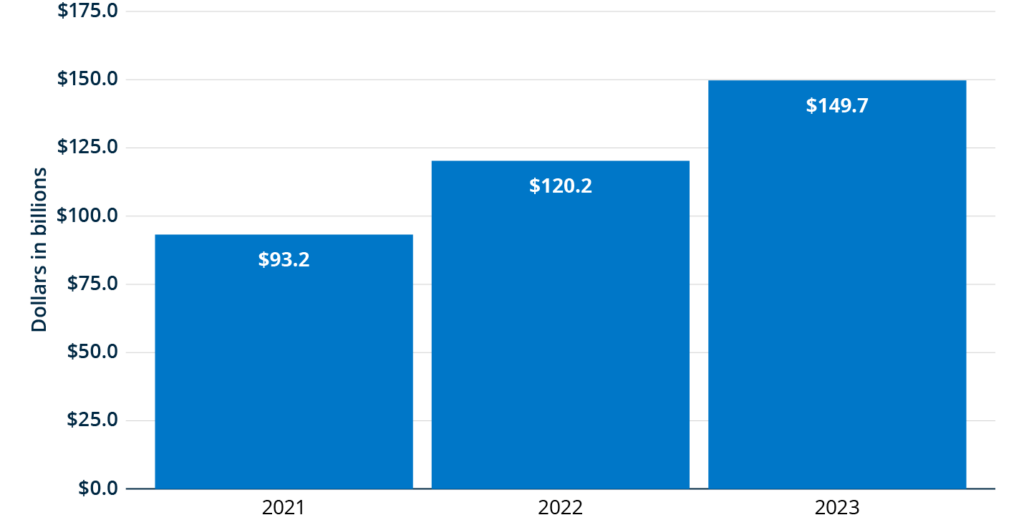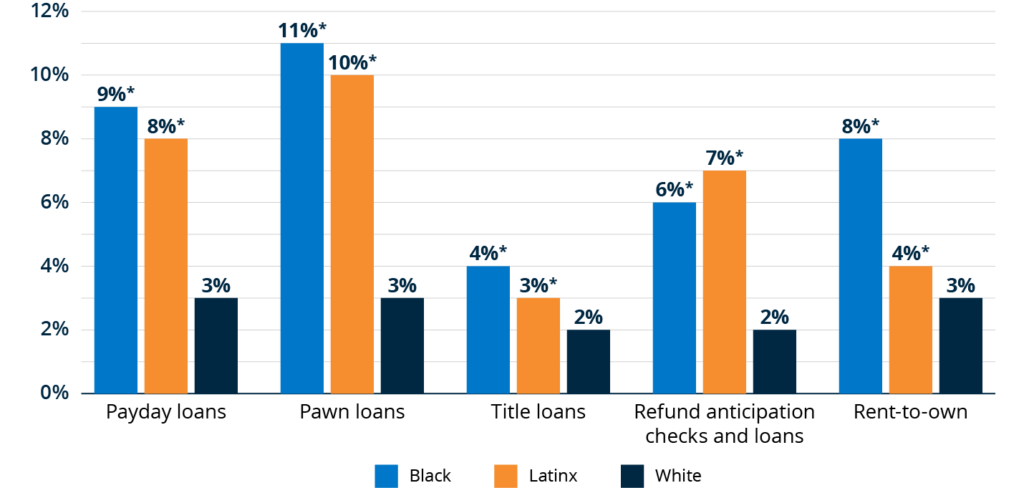FinHealth Spend Report 2024
By Hannah Gdalman, MK Falgout, Necati Celik, Ph.D., Meghan Greene
-
Program:
-
Category:
-
Tags:

U.S. Spending on Interest and Fees Tops $400 Billion
2023 was a year characterized by opposing forces: inflation slowed and real wages grew, yet interest rates remained high. How has spending on financial services changed against this backdrop? This year’s FinHealth Spend Report – our long-running national study on the costs of financial services to U.S. households – reveals that spending jumped 17%, reaching an all-time high of $415 billion. Our analysis shows that Americans are carrying higher credit balances, paying higher interest rates, and increasingly holding more debt than is manageable – signaling a growing financial burden that weighs most heavily on vulnerable households.

Vulnerable Populations Are Still Disproportionately Impacted
Financially Vulnerable households and households of color continue to pay an outsized portion of all spending on interest and fees. Financially Vulnerable households spent 16% of their income on average on interest and fees, compared with 6% and 1% for Financially Coping and Healthy households, respectively. Meanwhile, Black and Latinx households spent 8% and 6% of their incomes on interest and fees, respectively, while white households only paid 4%.
This year’s report suggests that high interest and credit card rates continue to fall disproportionately on those struggling the most, while macroeconomic pressures are contributing to increasing levels of consumer debt. We encourage business leaders, policymakers, and advocates to use this research to better understand consumer spending trends and design equitable solutions that improve financial health.
Spending at a Glance

Total spending increased 17% to reach a record $415 billion

The percentage of households holding an unmanageable amount of debt increased from 26% to 28%

Financially Vulnerable households spent 16% of their income on interest and fees on average

Consumer spending on overdraft fees decreased by $2.9 billion from 2020 to 2023
About the 2024 Report
For more than a decade, the FinHealth Spend Report has analyzed the cost of financial services for American households, particularly those struggling financially. In 2020, we debuted a new approach that blends extensive secondary research on financial products and trends with a nationally representative survey on financial service use. This report is the fourth annual publication under this revised methodology.
This year’s report features analysis of nearly two dozen financial products and services, including:
- Account maintenance fees
- ATM fees
- Auto leases
- Auto loans (new; used; and buy here, pay here)
- Buy now, pay later (BNPL)
- Nonbank check cashing
- Credit cards (general purpose and private label revolving accounts)
- Earned wage access (EWA)
- International remittances
- Money orders
- Overdraft/NSF fees
- Pawn loans
- Payday loans
- Prepaid cards
- Refund anticipation checks and loans
- Rent-to-own
- Secured cards
- Student loans (federal and private)
- Title loans
- Unsecured installment loans
Key Product Trends
Estimated spending on bank account fees dropped by 10% in 2023.
Total spending on bank account fees, in billions.

Total revenue from overdraft/nonsufficient funds (NSF) fees continued to contract, from an estimated $9.8 billion in 2022 to $7.9 billion in 2023.1 In contrast, annual revenue from account maintenance and ATM fees has increased by an estimated $1.6 billion since 2020. However, this does not fully counterbalance the decline in overdraft/NSF fees.
Overall bank account fees, including overdraft/NSF, account maintenance, and ATM fees, have decreased from an estimated $17.7 billion in 2020 to $16.4 billion in 2023.
Interest and fees from revolving general-purpose credit card balances continue to grow.
Total interest and fees from revolving general-purpose credit card balances, in billions.

The combination of rising credit balances and rising interest rates increased costs for consumers who carried a balance from month to month in 2023. Consumers who carried balances on general-purpose credit cards paid an estimated total of $150 billion, up approximately $30 billion from the prior year and more than $50 billion from 2021.
Notably, the proportion of respondents with revolving credit card debt who said they had unmanageable debt increased from an estimated 38% in 2022 to 42% in 2023.
Higher interest rates drove an increase in auto spending.
Total interest revenue from car loans for new and used cars, in billions.

Despite slightly lower average auto loan amounts, elevated interest rates and slightly shorter average loan terms contributed to higher monthly payments for borrowers in 2023.2
Total estimated interest from auto loans for new and used cars topped $100 billion for the first time, with about two-thirds (67%) of the total coming from auto loans for used vehicles. Total interest payments for new car loans also expanded from an estimated $29.8 billion in 2022 to $35.4 billion in 2023.
Spending on installment loans continues to expand.
Total interest and fees from unsecured installment loans, in billions

Total interest and fees from unsecured installment loans expanded from an estimated $37.0 billion in 2022 to $42.4 billion in 2023. However, we find a 3 percentage point decrease in the portion of households using installment loans – from 13% in 2022 to 10% in 2023.3
This decrease in originations may have been offset by higher loan balances. Average loan balances per borrower increased in 2023 to record-high levels, with the increase particularly pronounced among borrowers with credit scores near the top of the score range.4
Loan holders of color were more likely to report difficulty in making payments.
Percentage of federal student loan borrowers who said it was at least somewhat difficult to make their loan payments, by race and ethnicity.

Total estimated fees and interest on federal student loans doubled from $8.3 billion in 2022 to $16.6 billion in 2023, which corresponds with the resumption of federal student loan payments on October 1, 2023.5 Private student loan payments also expanded from an estimated $8.9 billion in 2022 to $11.0 billion in 2023, coinciding with increased interest rates for those with variable-rate loans.
As payments resumed, nearly half (46%) of federal student loan holders said that it was somewhat or very difficult to meet their student loan obligations.6 Loan holders of color were more likely to report difficulty, with 54% of Black and 42% of Latinx borrowers saying it was at least somewhat difficult to make their payments compared with 41% of white borrowers.
Households of color are more likely to use alternative credit products than white households.
Percentage of households that reported use of select alternative credit products over the last 12 months, by race and ethnicity.

Note: * Statistically significant difference (p < 0.05) relative to white households.
Although usage of alternative financial services appears to have stabilized in 2023, communities of color continue to use alternative credit products at disproportionately higher rates. For example, Black and Latinx households each reported using pawn loans at more than three times the rate of white households in 2023.
Overall, interest and fee revenue for these products increased by an estimated 4% between 2022 to 2023, which is slower than the 9% increase seen between 2021 and 2022.
Spending Disparities From 2022 Still Remain
Disparities by race and ethnicity and financial health tier remain at similar levels to prior years. Black, Latinx, and Financially Vulnerable households continue to pay more in interest and fees, as well as a greater share of their income, than white and Financially Healthy households, demonstrating that rising credit balances and interest rates are falling heavily on those who are less equipped to pay for them. For example, Financially Vulnerable households accounted for more than a quarter (27%) of the total spent on interest and fees in 2023, despite constituting only 15% of our survey sample. As economic uncertainties persist, it’s critical to understand the impact on those who struggle the most and work toward providing equitable solutions.

FinHealth Spend 2024 Report
Explore the trends. Discover new insights. Build stronger strategies.
Explore Additional Research
Dive deeper into consumer spending trends in our full lineup of FinHealth Spend research.
Life Insurance in America: Understanding and Closing Coverage Gaps
Many families lack any life insurance. Who holds life insurance, who should own it, and what can we do to better protect families?
FinHealth Spend Research
The FinHealth Spend Research estimates how much U.S. households pay each year for dozens of financial products and services, such as overdraft, credit cards, and auto loans.
Methodology in Brief
Our report leverages a unique multi-phase methodology that begins with in-depth secondary research and modeling to derive estimates of total spending on interest and fees by American households on dozens of financial products and services. This research is coupled with nationally representative survey data on their product use and outstanding debt over the previous 12 months. In this year’s report, we present data on product spending and usage spanning 2021 to 2023, three years marked by above-average inflation. We updated prior estimates to include the most recent data available for those years. For further methodological details, please see the full report.
Acknowledgments
We are thankful for the contributions of Zaan Pirani and Lisa Berdie and the continued strategic guidance and leadership from David Silberman, Angela Fontes, and Corey Stone. We are also grateful for the input of several of our colleagues at the Financial Health Network, including Fawziah Bajwa, Kennan Cepa, Dan Miller, Michael Salmassian, and Chris Vo.
This report benefits from insights and market intelligence from experts across the financial services industry, including the Center for Responsible Lending (CRL) and Self-Help Federal Credit Union, Consumer Financial Protection Bureau (CFPB), the Federal Reserve Bank of Philadelphia, and the Student Borrower Protection Center (SBPC).
This report is made possible through the financial support of Prudential Financial.
- Our analysis includes overdraft/NSF fee estimates for large banks (assets over $1 billion), small banks (less than $1 billion in assets), and credit unions.
- Melinda Zabritski, “State of the Automotive Finance Market Q4 2023,” Experian, February 2024.
- Our survey found that the portion of respondents with at least one installment loan usage dropped from 13% in 2022 to 10% in 2023. This change could be the result of multiple factors, namely fewer originations due to higher interest rates and changes to our survey question. See Appendix II, Section C for survey question details on these changes.
- “TransUnion Unsecured Personal Lending Industry Insights Report Q4 2024,” TransUnion, January 2024.
- “Interest Rates and Fees for Federal Student Loans,” Office of Federal Student Aid, Accessed March 2024.
- Survey response options were as follows: Very difficult; Somewhat difficult; Neither difficult nor easy; Somewhat easy; Very easy.
FinHealth Spend Report 2024
Explore the trends. Discover new insights. Build stronger strategies.

